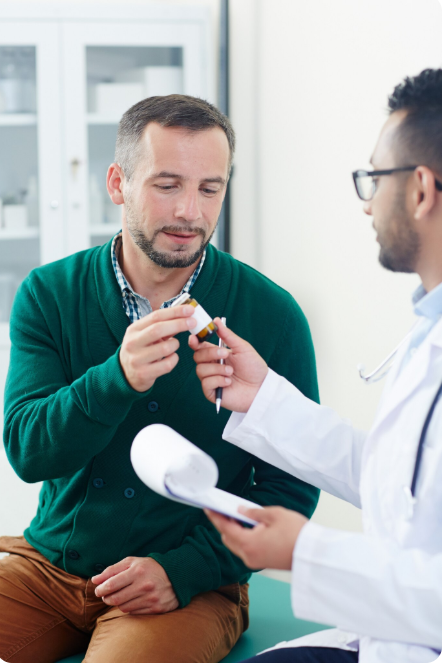If you’re experiencing difficulty conceiving and have been told you may have a varicocele, you’re not alone. Varicocele is one of the most common and reversible causes of male infertility. Understanding what a varicocele is, how it affects sperm production, and when to seek testing can help you take timely steps toward a solution.
What Is a Varicocele?
A varicocele is an enlargement of the veins within the scrotum, similar to varicose veins in the legs. These veins are part of the pampiniform plexus, which help regulate testicular temperature.
Normally, blood flows smoothly through these veins, but with a varicocele, faulty valves allow blood to pool, causing the veins to dilate and heat to build up in the scrotum. This increased temperature can impair sperm production and function.
Key Facts:
- Affects 15% of all men
- Present in up to 40% of men with primary infertility
- Present in up to 80% of men with secondary infertility (those who previously fathered children)
How Does Varicocele Affect Fertility?
Varicoceles can impair male fertility in several ways:
🔥 Increased Scrotal Temperature
Sperm production (spermatogenesis) is highly sensitive to temperature. Varicoceles raise testicular temperature by 2–3°C, which can impair sperm development.
🧬 Oxidative Stress and DNA Damage
Varicoceles increase the production of reactive oxygen species (ROS), which can damage sperm DNA and impair embryo development.
📉 Decreased Testosterone
Varicoceles can negatively affect Leydig cells, which produce testosterone. This may result in low libido and poor sperm quality.
🧪 Semen Abnormalities
Men with varicoceles often show:
- Low sperm count (oligospermia)
- Poor sperm motility (asthenozoospermia)
- Abnormal sperm shape (teratozoospermia)
- Increased sperm DNA fragmentation
Signs and Symptoms of Varicocele
Many varicoceles are asymptomatic and discovered during a fertility workup. However, some men may experience:
- Dull or aching pain in the scrotum
- A feeling of heaviness or dragging
- Visible or palpable enlarged veins (“bag of worms” appearance)
- Smaller testicle on the affected side (usually the left)
When to Get Tested for Varicocele
You should consider evaluation for varicocele if:
- You’ve been trying to conceive for 12 months or more without success
- A semen analysis shows low count, poor motility, or abnormal morphology
- You experience scrotal discomfort or visible scrotal veins
- You have a history of testicular trauma or asymmetry in testicle size
- You have secondary infertility (previously fathered a child but now unable)
How Is Varicocele Diagnosed?
👨⚕️ Physical Examination
- Performed while standing and during Valsalva maneuver (bearing down)
- Grade I: Palpable only with Valsalva
- Grade II: Palpable without Valsalva
- Grade III: Visible through the scrotal skin
🩻 Scrotal Ultrasound
- Confirms diagnosis when physical exam is inconclusive
- Measures vein diameter and evaluates blood flow
- A vein diameter >2.5–3 mm with reflux is considered diagnostic
Should You Treat a Varicocele?
Treatment is recommended if:
- The varicocele is clinically palpable
- You and your partner are experiencing infertility
- Semen analysis is abnormal
- There is testicular atrophy (shrinkage)
- You have scrotal pain
Treatment Options for Varicocele
🛠️ Varicocelectomy (Surgical Repair)
- Ligation of dilated veins to restore normal blood flow
- Approaches: microsurgical (subinguinal or inguinal), laparoscopic, or open surgery
- Microsurgical varicocelectomy is the gold standard due to high success and low complication rates
🧬 Outcomes After Surgery
- Improved sperm concentration, motility, and morphology in 60–70% of men
- Increased spontaneous pregnancy rates (30–50%)
- Decreased DNA fragmentation and oxidative stress
- Improved testosterone levels in some patients
🩹 Percutaneous Embolization
- Minimally invasive, catheter-based technique
- Less common but an alternative for men who are not surgical candidates
When Not to Treat
Treatment may not be necessary if:
- The varicocele is subclinical (not palpable and no symptoms)
- Semen parameters are normal
- You are not actively trying to conceive
- Advanced female age or other urgent fertility concerns require immediate ART (e.g., IVF)
Final Thoughts
Varicoceles are common—and in many cases, treatable—causes of male infertility. If you’re experiencing trouble conceiving, or if a semen analysis has shown abnormal results, don’t wait. Getting tested for varicocele can uncover an important (and correctable) factor in your fertility journey.
Early evaluation can lead to timely intervention, improve your chances of natural conception, and even enhance the success of assisted reproductive treatments.
Keywords: varicocele and infertility, varicocele testing, varicocele treatment for male infertility, semen analysis varicocele, low sperm count varicocele, testicular varicocele symptoms, male infertility causes
Would you like a follow-up article on “Microsurgical Varicocelectomy: What to Expect Before and After” or a patient FAQ download to accompany this post?




